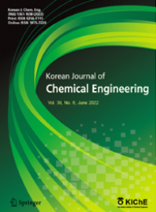Overall
- Language
- English
- Conflict of Interest
- In relation to this article, we declare that there is no conflict of interest.
- Publication history
-
Received June 25, 2023
Accepted November 9, 2023
-
 This is an Open-Access article distributed under the terms of the Creative Commons Attribution Non-Commercial License (http://creativecommons.org/licenses/bync/3.0) which permits
unrestricted non-commercial use, distribution, and reproduction in any medium, provided the original work is properly cited.
This is an Open-Access article distributed under the terms of the Creative Commons Attribution Non-Commercial License (http://creativecommons.org/licenses/bync/3.0) which permits
unrestricted non-commercial use, distribution, and reproduction in any medium, provided the original work is properly cited.
Most Cited
New Approach for Activation of N 2 -Selective ETS-4 Membrane for Nitrogen Separation from N 2 /CH 4 Mixture
https://doi.org/10.1007/s11814-024-00033-4
Abstract
Microporous titanosilicate ETS-4 zeotype membrane, with its 4 Å pore openings, is an adequate material for the kinetic
separation of nitrogen from methane. Obtaining high N 2 /CH 4 permselectivity, small-sized ETS-4 powder was synthesized
by aging method, and then utilized as membrane seeding powder. Highly N 2 -selective ETS-4 membranes were fabricated
utilizing a new recipe and the secondary growth approach on α-alumina supports. XRD, FESEM, and EDX studies were
used to analyze the synthesized ETS-4 powder and membranes. The eff ect of membrane activation temperature (80–140 °C)
on permeance of N 2 was evaluated. In addition to N 2 and CH 4 , the membrane permeance was also evaluated for O 2 and Ar
gases. Regarding the ETS-4 membranes, N 2 permeance increased gradually as the activation temperature was raised in the
80–140 °C range, reaching its highest value (i.e., 2.6 × 10 −8 mol m −2 s −1 Pa −1 ) after activation at 140 °C. The permeances
of N 2 and CH 4 gases were measured at 30, 50, and 70 °C, and a pressure diff erence up to 600 kPa. N 2 /CH 4 permselectivity
of 75.19 (N 2 permeance of 1.94 × 10 –8 mol m- 2 s −1 Pa −1 ) were obtained at 30 °C and 200 kPa of feed pressure. The results
revealed that ETS-4 membranes have great potential for N 2 removal from natural gas due to highest N 2 /CH 4 permselectivity
among the other membranes.

